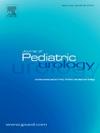Does the addition of hyaluronidase to betamethasone in topical treatment of phimosis improves results? – A randomized double-blind clinical trial
IF 2
3区 医学
Q2 PEDIATRICS
引用次数: 0
Abstract
Introduction
Phimosis is defined as the inability to retract the foreskin, preventing partial or complete exposure of the glans.
Objectives
To compare the efficacy of topical treatment with betamethasone alone and in combination with hyaluronidase, evaluate systemic absorption of cortisol, and identify factors that predispose the success of topical treatment of phimosis in children aged 3–10 years.
Methods
This randomized double-blinded clinical trial involved 152 participants (3–10 years old) with phimosis. The children were divided into two groups: betamethasone associated with hyaluronidase (betamethasone valerate 2.5 mg + hyaluronidase 150 UTR; Group A) and betamethasone (betamethasone valerate 2.5 mg; Group B). Parents were instructed on how to use the ointment (twice a day, after hygiene, for 60 days) and on collecting salivary cortisol measurements at 11pm and 9am, before and after treatment. Participants were evaluated after 30 and 60 days. Fisher's exact test and paired t-test were used to analyze the data.
Results
Ninety children (69.77%) were successfully treated with the proposed treatment, with the success rate for Group A being 75.38% versus 64.06% for Group B, p = 0.18). Systemic absorption evaluated by salivary cortisol did not show differences after the intervention (p > 0.05), indicating that there was no systemic absorption when using ointments with or without hyaluronidase. The factors of age (OR = 0.98 – CI: 0.97–1.00), adherence (OR = 1.49 – CI: 0.53–4.16), balanoposthitis (OR = 1.85 – CI: 0.47–7.19), and previous use of corticosteroids (OR = 1.21 – CI: 0.53–2.72) also did not show influenced results
Conclusion
Topical therapy for true phimosis with betamethasone 0.2% + hyaluronidase, despite showing no differences when compared with betamethasone 0.2% alone, for a period of up to 60 days, proved to be safe, effective, and with good results. The variables analyzed could not predict the expected clinical response.
ReBEC
RBR-76bhgyb.
在包皮龟头炎的局部治疗中添加透明质酸酶和倍他米松是否能提高疗效?- 随机双盲临床试验
摘要:包皮过长是指包皮不能退缩,导致龟头不能部分或完全外露。目的比较单独使用倍他米松和与透明质酸酶联合使用进行局部治疗的疗效,评估皮质醇的全身吸收情况,并确定3-10岁儿童包皮过长局部治疗成功的诱因。这些儿童被分为两组:倍他米松联合透明质酸酶(戊酸倍他米松 2.5 毫克 + 透明质酸酶 150 UTR;A 组)和倍他米松(戊酸倍他米松 2.5 毫克;B 组)。指导家长如何使用药膏(每天两次,在清洁卫生后使用,持续 60 天),并在治疗前后的晚上 11 点和上午 9 点收集唾液皮质醇测量值。30 天和 60 天后对参与者进行评估。结果 90 名儿童(69.77%)成功接受了建议的治疗,A 组的成功率为 75.38%,B 组为 64.06%,P = 0.18)。通过唾液皮质醇评估的全身吸收情况在干预后没有显示出差异(p >0.05),表明使用含或不含透明质酸酶的软膏时没有全身吸收。年龄(OR = 0.98 - CI:0.97-1.00)、依从性(OR = 1.49 - CI:0.53-4.16)、包皮龟头炎(OR = 1.85 - CI:0.47-7.19)和既往使用过皮质类固醇激素(OR = 1.21 - CI:0.53-2.72)等因素也没有对结果产生影响。结论使用倍他米松 0.2%+ 透明质酸酶局部治疗真性包皮龟头炎,尽管与单独使用倍他米松 0.2% 治疗真性包皮龟头炎相比没有差异,但治疗时间长达 60 天,证明是安全、有效且效果良好的。所分析的变量无法预测预期的临床反应。
本文章由计算机程序翻译,如有差异,请以英文原文为准。
求助全文
约1分钟内获得全文
求助全文
来源期刊

Journal of Pediatric Urology
PEDIATRICS-UROLOGY & NEPHROLOGY
CiteScore
3.70
自引率
15.00%
发文量
330
审稿时长
4-8 weeks
期刊介绍:
The Journal of Pediatric Urology publishes submitted research and clinical articles relating to Pediatric Urology which have been accepted after adequate peer review.
It publishes regular articles that have been submitted after invitation, that cover the curriculum of Pediatric Urology, and enable trainee surgeons to attain theoretical competence of the sub-specialty.
It publishes regular reviews of pediatric urological articles appearing in other journals.
It publishes invited review articles by recognised experts on modern or controversial aspects of the sub-specialty.
It enables any affiliated society to advertise society events or information in the journal without charge and will publish abstracts of papers to be read at society meetings.
 求助内容:
求助内容: 应助结果提醒方式:
应助结果提醒方式:


